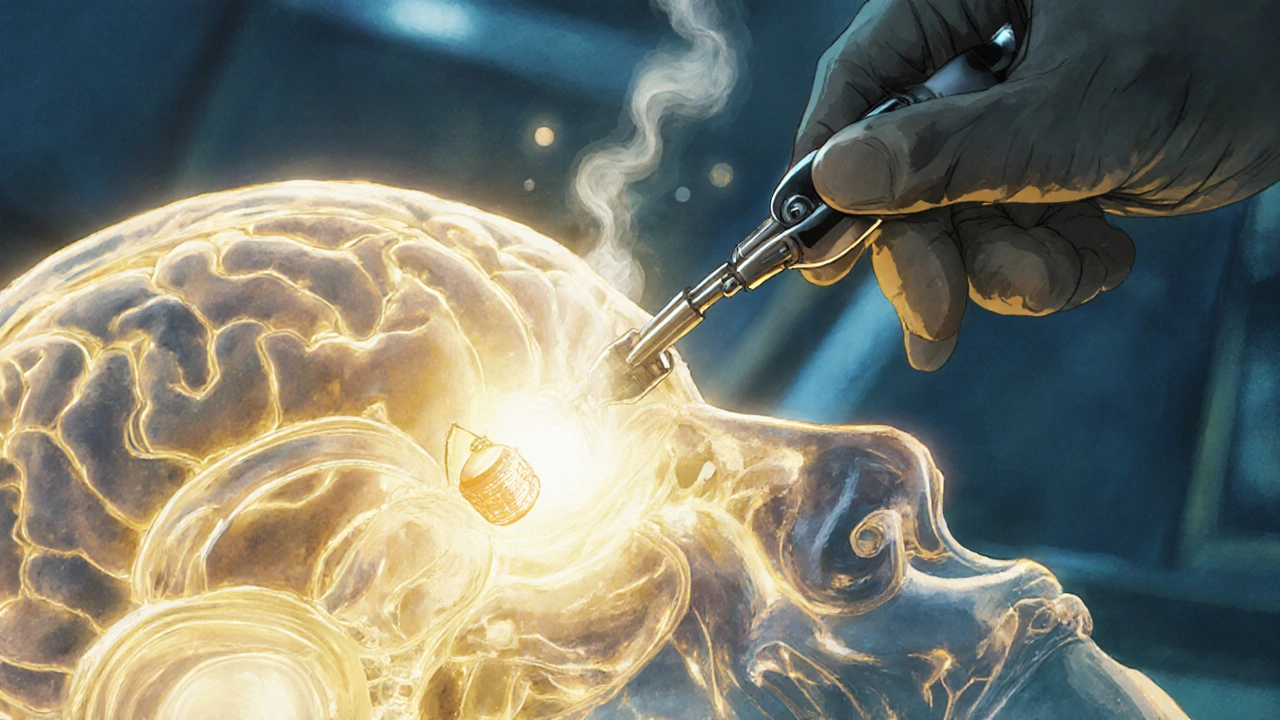
When your body makes too much cortisol - the stress hormone that keeps you alert, regulates blood sugar, and controls inflammation - it doesn’t just make you feel tense. It breaks you down. Over time, excess cortisol causes your face to swell into a round, moon-like shape. Your trunk grows fat while your arms and legs stay thin. Purple stretch marks appear on your skin like bruises you didn’t get from anything. Your bones weaken. Your blood pressure spikes. You might stop sleeping, lose muscle, or develop diabetes. This isn’t just being stressed out. This is Cushing’s syndrome.
What Exactly Is Cushing’s Syndrome?
Cushing’s syndrome happens when your body is flooded with cortisol for months or years. Normally, your adrenal glands make just enough cortisol to handle daily stress - about 5 to 25 micrograms per deciliter of blood. In Cushing’s, levels can jump to 50, 100, even 200 mcg/dL. That’s not a small bump. It’s a full-blown hormonal storm.
There are two main types. The first, and most common, is exogenous Cushing’s - caused by taking steroid medications like prednisone for asthma, arthritis, or autoimmune diseases. About 80% of all cases fall into this category. The second type, endogenous Cushing’s, comes from inside your body. That’s when a tumor - usually in the pituitary or adrenal gland - starts making too much ACTH or cortisol on its own. Only about 20% of cases are endogenous, but those are the ones that need surgery.
Women between 20 and 50 are most often affected. In fact, 7 out of 10 people diagnosed with endogenous Cushing’s are women. The condition is rare - only 10 to 15 people per million get it each year - but the damage it causes is severe and often irreversible if left untreated.
How Do You Know You Have It?
There’s no single test. Doctors look for patterns. If you have central obesity, a fatty hump between your shoulders, thin skin that bruises easily, and high blood pressure - especially if you’re a woman in your 30s or 40s - that’s a red flag.
Three key tests confirm the diagnosis:
- Late-night salivary cortisol: Levels above 0.14 mcg/dL suggest excess production.
- 24-hour urine cortisol: Over 50 mcg in a day means your body is making too much.
- Low-dose dexamethasone test: If your cortisol stays high after taking a steroid pill meant to shut it down, your system isn’t responding normally.
These tests aren’t just paperwork. They’re life-saving. About 70% of patients have impaired glucose tolerance, 85% have high blood pressure, and half develop osteoporosis so bad their spine fractures from coughing. Left alone, Cushing’s doubles your risk of dying from heart disease or infection.
Why Surgery Is the First Choice
Medications exist - drugs like pasireotide or mifepristone - but they’re not cures. They just manage symptoms. And they cost $5,000 to $10,000 a year. Surgery, on the other hand, can remove the source of the problem entirely.
The Endocrine Society’s 2020 guidelines say this clearly: for endogenous Cushing’s caused by a tumor, surgery is the first-line treatment. Why? Because it works. And it’s the only way to get back to normal without lifelong pills.
The type of surgery depends on where the tumor is:
- Pituitary tumor (Cushing’s disease): 60-70% of endogenous cases. Treated with transsphenoidal surgery - a procedure where the surgeon goes through the nose to reach the pituitary gland. It takes 2-4 hours. Most people go home in 2-5 days.
- Adrenal tumor: 15-20% of cases. Treated with laparoscopic adrenalectomy - removing the affected adrenal gland through small belly incisions. Usually done in under 2 hours, with a 1-2 day hospital stay.
- Ectopic tumor: 5-10% of cases. These tumors grow outside the pituitary or adrenal glands - often in the lungs or pancreas. Surgery is harder, but still the best shot at cure.
Success rates vary. For small pituitary tumors (under 10 mm), remission happens in 80-90% of cases. For larger ones, it drops to 50-60%. Adrenal tumors? 95% cure rate. Bilateral adrenalectomy - removing both adrenal glands - cures 100% of cases, but then you need to take cortisol and aldosterone replacement for the rest of your life. And there’s a 40% chance you’ll develop Nelson’s syndrome - a fast-growing pituitary tumor - within five years.

What Happens After Surgery?
Surgery doesn’t end the journey. It just changes it.
Right after surgery, your body goes into shock. For years, your adrenal glands were being told to pump out cortisol by a tumor. Suddenly, that signal is gone. Your body has no idea how to make its own cortisol again. So you go into adrenal insufficiency.
You’ll need hydrocortisone - a synthetic cortisol - for weeks or months. About 70% of patients need it for 3-6 months. 10% will need it forever. You’ll have to learn how to adjust your dose during illness, injury, or stress. Miss a dose, and you could go into adrenal crisis - low blood pressure, vomiting, passing out. It’s life-threatening.
Recovery takes time. Most people report feeling better within 3-6 months. The moon face fades. The purple streaks lighten. Blood pressure drops. But fatigue lingers. Many patients say they feel like a ghost of themselves for months. Some need thyroid or testosterone replacement after surgery. One patient on a support forum lost 40 pounds in two months after successful pituitary surgery. Another, two years out, still struggles with energy and needs hormone replacements.
Long-term, quality of life improves dramatically. Studies show 85% of patients report major life improvements by the one-year mark. But 15% still need more surgery, radiation, or meds. And even after cure, your risk of heart disease stays higher than average for years.
Where You Get Surgery Matters - A Lot
This isn’t like having your appendix out. This is brain or adrenal surgery for a rare disease. And outcomes depend almost entirely on the surgeon’s experience.
Centers that do fewer than 10 pituitary surgeries a year have remission rates of only 50-60%. Centers that do 20 or more per year? 80-90%. That’s a huge gap.
Experts like Dr. Maria Fleseriu and Dr. Edward Laws say the key to success is volume. High-volume surgeons know how to find tiny tumors on MRI, how to avoid damaging the pituitary, how to manage complications like CSF leaks. They’ve seen it all.
Yet only 15% of patients in the U.S. get treated at these specialized centers. Most go to local hospitals. That’s why recurrence rates are so high - and why so many people end up needing repeat surgery.
Insurance doesn’t always help. Medicare covers about 85% of pituitary surgery costs. But private insurers deny 20% of initial adrenalectomy requests. Patients spend months fighting for coverage while their health declines.

New Tech Is Changing the Game
Things are getting better. In 2023, the FDA approved a new 3D endoscopic system called the Neuro-Robotic Scope. It gives surgeons a clearer, magnified view of the pituitary. Early results show a 40% drop in CSF leaks and 25% faster surgery time.
Another breakthrough? Molecular imaging. A new PET scan using 11C-metomidate can spot tiny tumors that MRI misses. In trials, it improved tumor detection from 70% to 95%. That means more people get cured on the first try.
And the NIH’s CUREnet registry - tracking over 1,000 patients - shows something powerful: if you have surgery within 18 months of diagnosis, your chance of remission is 85%. Wait beyond two years? It drops to 65%.
These aren’t just numbers. They’re chances to live a normal life.
What Should You Do If You Suspect Cushing’s?
If you’ve had unexplained weight gain, high blood pressure, easy bruising, or muscle weakness for more than six months - and you’re not on steroids - ask your doctor about Cushing’s. Don’t wait. Don’t assume it’s just aging or stress.
Insist on the three key tests. Ask if you can be referred to a pituitary or endocrine center that does at least 20 of these surgeries a year. If your doctor says, “It’s rare, let’s just monitor,” push back. This isn’t a condition you can watch and wait on.
And if surgery is recommended - go. Even with the risks, even with the recovery, even with the lifelong steroid management - it’s still the best shot you have at getting your life back.
People who wait too long often end up with fractures, heart attacks, or strokes. Those who act early - even if they’re scared - usually walk out of the hospital with a future they thought was gone.
Can Cushing’s syndrome be cured without surgery?
Medications like pasireotide or mifepristone can lower cortisol levels and manage symptoms, but they don’t remove the tumor causing the problem. They’re used when surgery isn’t possible or while waiting for surgery. Long-term, they’re less effective than surgery and cost thousands per year. Surgery remains the only true cure for endogenous Cushing’s syndrome.
How long does it take to recover after Cushing’s surgery?
Physical recovery from surgery takes days to weeks, but full hormonal recovery takes months. Most people notice improvements in energy, skin, and weight within 3-6 months. However, adrenal insufficiency can last 6-12 months or longer. Full return to normal activity, including work, often takes 3-6 months. Some patients need up to two years to feel completely like themselves again.
Is bilateral adrenalectomy a good option?
Bilateral adrenalectomy - removing both adrenal glands - is 100% effective at curing cortisol overproduction. But it means you’ll need lifelong hormone replacement for cortisol and aldosterone. There’s also a 40% risk of developing Nelson’s syndrome, a fast-growing pituitary tumor, within five years. It’s usually reserved for cases where other treatments have failed or for patients with severe, uncontrolled disease.
Why do some people need repeat surgery?
About 10-25% of patients experience a return of symptoms within 10 years. This can happen if the tumor wasn’t fully removed, if it regrows, or if there are multiple small tumors. Pituitary macroadenomas (larger than 10 mm) are more likely to recur. Repeat surgery is possible and often successful, especially at high-volume centers.
Can Cushing’s syndrome come back after successful surgery?
Yes. Even after successful surgery and normal cortisol levels, recurrence is possible. Studies show 10-25% of patients relapse within 10 years. That’s why lifelong monitoring is essential. Regular blood and urine tests, along with annual MRIs for pituitary cases, help catch recurrence early - when it’s still treatable.
14 Comments
Write a comment
More Articles

Fexofenadine and Fruit Juice: Why Your Allergy Medicine Might Not Work
Fexofenadine (Allegra) can lose up to 77% of its effectiveness when taken with orange, apple, or grapefruit juice. Learn why this happens, how to avoid it, and which allergy meds don’t have this problem.

Top 10 Effective Alternatives to Flagyl in 2024
Flagyl is often prescribed to deal with various infections, but not everyone can tolerate it. Fortunately, there are several effective alternatives available in 2024 that cater to different needs and situations. From Tinidazole's convenient dosing schedule to Clotrimazole's dual action, each alternative holds unique benefits and considerations. This article explores ten alternatives, highlighting their pros and cons, to guide readers in making informed decisions.


Chrisna Bronkhorst
November 12, 2025 AT 20:23Wow this is the most detailed post I've ever seen on Cushing's. Seriously, someone should turn this into a pamphlet for doctors. The part about surgery volume hitting 80-90% remission at high-volume centers? That's the whole damn point. Why are people settling for local hospitals when their life's on the line?